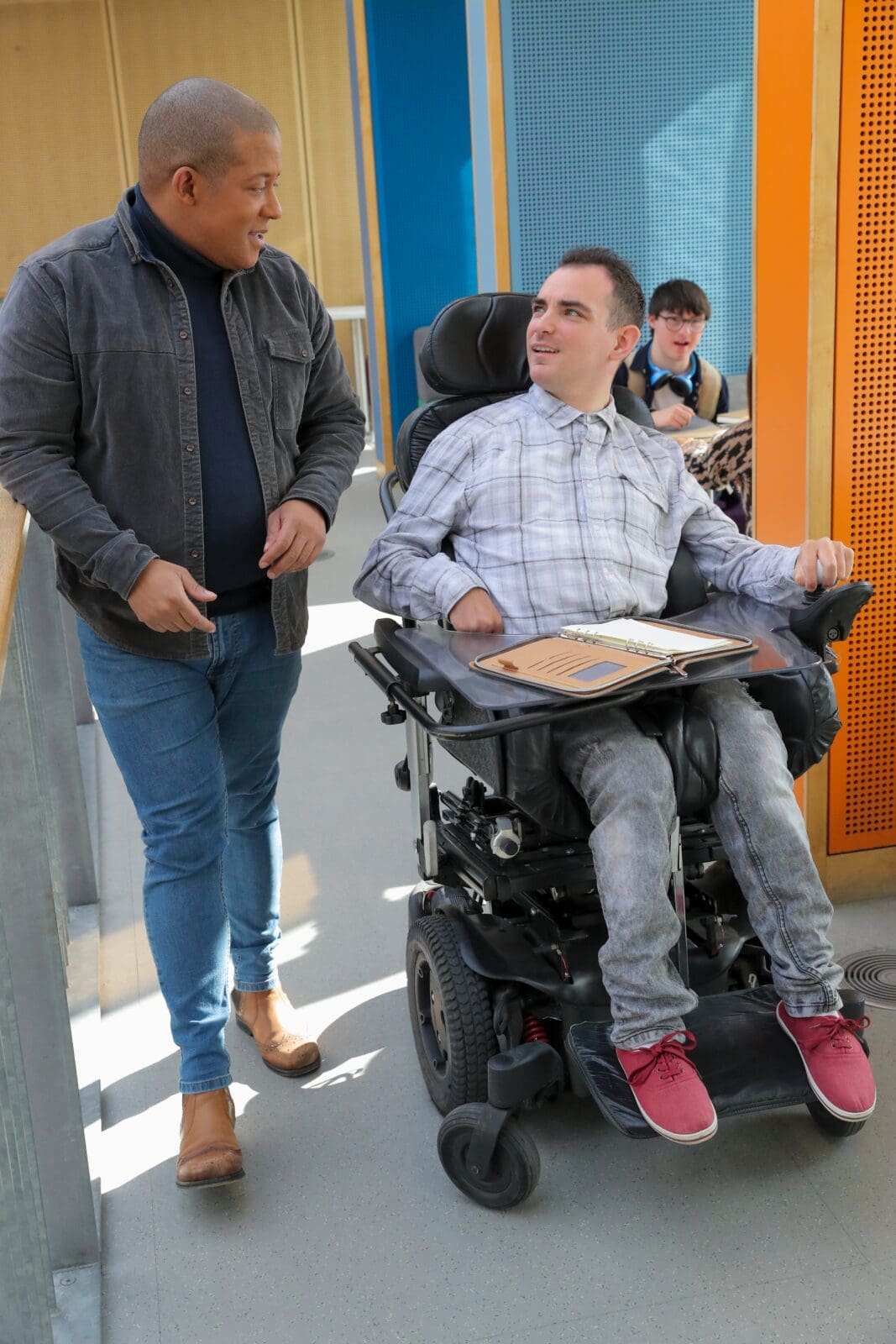SENCO CV Guide
Everything you need to know about getting the perfect SENCO CV
A SENCO (Special Educational Needs Coordinator) is a teacher who works in schools and oversees and coordinates the support for children with special educational needs (SEN). They ensure appropriate strategies, resources, and interventions are in place to help students thrive in their learning environment. SENCOs also collaborate with teachers, parents and external professionals to create inclusive educational experiences. When schools look at recruiting SENCOs, they will look for candidates with in-depth
knowledge of SEN, specific qualifications, and unique skills and personal qualities. If you plan on applying for a SENCO role, you must communicate to hiring managers and recruiters why you are the best fit for the job, which you will aim to achieve through a well- crafted CV.
How you write your CV is up to you. However, you must include the most relevant information, summarising your education, work experience, skills and achievements and structure it into clear and concise sections to make it eye-catching and easy to read. You
must also tailor your CV to each SENCO position you apply for, as it will help you get noticed by prospective employers.
In this article, we will provide guidance on how to write a SENCO CV, what to include, some tips and an example to help you get started. It will hopefully increase your chances of securing an interview and, ultimately, the job.
In this SENCO CV guide
What to include in a SENCO CV
You may have seen various types of CVs and noticed they vary in design, structure and content. However, one thing that many people’s CVs have in common is the main sections, such as contact information, professional summary, education, work experience, skills, achievements and references. You will want to ensure your CV contains these sections to provide a framework to work to and to make it easier for those reading your CV to pick out pertinent details.
While other candidates’ CVs will have similar sections, what will set yours apart is tailoring each of these sections to the specific SENCO position, including relevant information and highlighting your passion for supporting students with special educational needs. You will also need to ensure your CV is an overview rather than trying to cram it with every detail. Think of it as giving prospective employers an introduction rather than telling them your entire academic and professional history.
Before putting pen to paper or typing your CV, thoroughly review the job description to identify the school’s requirements and identify how you align with their needs. You can make notes or do a mind map to help you decide what to include. Once you are ready to add your information, break down each section into manageable chunks and tackle them one at a time. Let us look at how you can do this and what information you may want to consider including.
Contact information
The first and probably easiest section of your CV is your contact information. Here, you should provide accurate details to make it as easy as possible for recruiters to contact you, such as:
- Your full name – display your name prominently at the top of the CV in a larger, bold font to make it stand out. For example, “Joe Taylor”. Do not worry about including any middle names; your first and last are sufficient.
- Your professional job title (optional) – some choose to include their previous or current job title, e.g. “SENCO”.
- Location – include your town/city and/or county (e.g. “Birmingham, West Midlands”). You do not need to provide your full home address unless specifically requested by the employer.
- Phone number – use a reliable and active phone number. If you have a voicemail, ensure it sounds professional.
- Professional email address – use a formal email address (e.g. joe.taylor@example.com) that avoids nicknames or unprofessional phrases.
- LinkedIn profile (optional) – include the link if you have a well-maintained LinkedIn profile. Ensure your profile aligns with the content of your CV and highlights relevant experience for the SENCO role.
- Professional website or portfolio (optional) – if applicable, you can include links to a portfolio or professional website showcasing relevant projects or credentials.
Your contact information should be at the top of your CV, either in the centre of the document or to the side. Keep it concise, well-organised and professional.
It is important to exclude some information from your CV because of security and privacy risks and potential bias and discrimination, e.g. a photo, date of birth, age, marital status, religion, personal social media page and national insurance number.
Professional summary (career objective statement)
A professional summary is also called a personal statement, professional profile or executive summary, which typically goes below your contact information. It briefly highlights your relevant qualifications, skills, experience, achievements and career goals. Think of it as a short, catchy introduction that tells someone who you are and what you are good at.
Crafting a well-written professional summary sets the tone for the rest of your CV and encourages the reader to continue reading. It is your opportunity to make a strong first impression and showcase why you are a fantastic fit for the role.
So, how do you write your professional summary, and what should you include? Here are some pointers to help you craft an impressive summary:
- Keep your summary concise and clear – ideally, stick to a paragraph between three and five lines.
- Start with a strong opening statement – begin the paragraph with a compelling sentence that captures your current role and years of experience, e.g. “Dedicated SENCO with over 7 years of experience in inclusive education and supporting students with diverse learning needs”.
- Mention any relevant certifications, training and education – for example, Master’s degree in special needs education, certified training in autism spectrum disorder (ASD), behaviour management, the National Award for SEN Coordination, etc.
- Highlight key skills – mention your core skills and areas of expertise relevant to the SENCO role, such as knowledge of SEN legislation and statutory frameworks, curriculum adaptation, individualised education plans (IEPs) and support for students with diverse needs.
- Emphasise your notable achievements – highlight specific accomplishments and contributions in previous roles. For example, “Proven track record of raising achievement levels for SEN pupils through tailored interventions and collaborative team leadership”.
- Demonstrate your passion and goals – include a personal touch that reflects your dedication to supporting students with special educational needs. For example, “Passionate about empowering children with additional needs to reach their full potential in education and beyond”.
Here is an example of what a professional summary for a SENCO might look like:
“Dedicated and experienced SENCO with 7 years of expertise in supporting students with diverse needs. Skilled in fostering inclusive learning environments, managing EHC plans, and collaborating with stakeholders to deliver tailored interventions. Holds a PGCE and the National Award for SEN Coordination, strongly committed to promoting equal opportunitis and helping every child thrive academically and personally.”
Keep your tone professional but approachable. Tailor it to reflect your unique experience and skills and the specific role you are applying for.
Education
As SENCOs need specific qualifications, include your relevant academic background in your CV to demonstrate your expertise and suitability for the role. It helps prospective employers to confirm that you have the necessary education, certifications, training, and knowledge to help students with special educational needs. It also shows you are always trying to learn and improve, which is a good quality for a SENCO.
The education section of your CV can be under your professional summary or after your work experience. If you are applying for your first SENCO job, you may want to focus on your academic background and add your education first. It is entirely your choice.
When you write the education section of your CV, you should add your qualifications in reverse chronological order (most recent first). You should also focus on those relevant to teaching and special educational needs. Here is an example of what to include:
- Undergraduate and postgraduate degrees – start with your most recent degree and work backwards. Include the following information:
- Degree title, e.g. Bachelor of Education (BEd) or Postgraduate Certificate in Education (PGCE).
- Institution name and location.
- Graduation date or the period of attendance.
- Grades awarded or anticipated (if applicable).
- Relevant coursework (optional).
- Include relevant training and certifications – mention certifications typically mandatory for SENCOs, such as Qualified Teacher Status (QTS) and a National Award for SEN Coordination, and ensure they are prominent in your CV. Detail any additional certifications or training specifically related to special education, such as courses on autism, dyslexia, behaviour management or inclusive teaching practices.
- Highlight Academic Achievements – if you graduated with honours or received any academic awards, include those details to emphasise your academic excellence, e.g.”Graduated with Distinction”.
- General education – add lower qualifications, such as GCSEs/A levels, but only if you have sufficient space on your CV, the job posting asks for them and/or they add value to your CV.
Here is an example of how you might want to add your education:
Education
- National Award for SEN Coordination (NASENCO), [Institution Name and Location], [Year].
- PGCE in Primary Education with QTS, [Institution Name and Location], [Year].
- BA in Psychology, [Institution Name and Location], [Year].
- CPD: Understanding Autism, Dyslexia Awareness, Behaviour Management Strategies, [Year(s)].
Work experience/employment history
Work experience, or your employment history, can go before or after your education section. In this section, you will provide information about your previous and current roles, detailing the responsibilities, achievements and skills you have gained in your career.
When you add your work experience to your CV, you provide a snapshot of your professional journey and show potential employers how your experience aligns with the role you are applying for. It is important, as it highlights your suitability for the role, demonstrates your skills in real-world settings, builds credibility and helps differentiate you from other candidates.
For a SENCO, focus on roles where you have worked in SEN, education or leadership and include prior teaching or related positions that build your SENCO story. Be concise, detail the most relevant aspects, and add your roles in reverse chronological order (most recent first). Here are some pointers on what to include in this section:
- Heading: Include a heading, “Work Experience” or “Employment History”.
- Job title: Clearly state your job title for each of your previous roles, e.g. “Special Educational Needs Coordinator (SENCO)”.
- Employer/organisation name: Include the name of the school or other organisation you worked for.
- Location: Add where you worked, i.e. town, city or county.
- Dates of employment: Mention the month and year you started and ended each role. If you are still currently employed, add “present” instead.
- Key duties – highlight your key responsibilities in bullet point form. Keep it brief and aim for three to five bullet points. You can also add your notable achievements and skills here or include them in a separate section.
Here is an example of how you can add your work experience:
Special Educational Needs Coordinator (SENCO). Greenwood Primary School, Manchester. Sept 2018 – Present
- Designed and implemented school-wide SEN strategies, ensuring compliance with statutory frameworks.
- Coordinated over 30 EHC plans and facilitated regular reviews with parents and local authorities.
- Mentored staff in adapting teaching approaches, resulting in a 15% rise in SEN pupil outcomes.
- Established partnerships with local authorities and therapy services to enhance support for students with complex needs.
Key skills and achievements
Key skills are the abilities and expertise you develop through learning, practice and experience. When you include your skills for a SENCO position, you highlight your ability to support students with additional needs, collaborate with stakeholders and lead inclusive practices.
There are two main types of skills, hard and soft, which you will want to blend into your CV to stand out to potential employers.
- Hard skills – are technical, job-specific skills often measurable and learned through training, education, or practice. They tend to be more tangible and easier to quantify. Some hard skills for a SENCO include knowledge of the SEND Code of Practice, EHC plan management, data analysis, budget management, inclusive practices, differentiated teaching strategies, assistive technology, education management systems, safeguarding, etc.
- Soft skills – are personal traits and interpersonal abilities that influence how you interact with others and handle situations. They are more about behaviour and character, often less tangible but equally important in the workplace. Some soft skills for a SENCO include empathy, patience, communication, problem-solving, adaptability, leadership, team management, collaboration, conflict resolution, etc.
You can include your key skills in your work experience with your previous responsibilities or in a separate section. Before adding them, look at the job posting to see if the school have asked for specific skills and include those most relevant to the SENCO position. They may use applicant tracking systems (ATS) that scan for particular words in CVs, so using similar language can increase your chances of passing through these filters and getting an interview.
You can also add your achievements alongside your key skills, demonstrating your skills in action and tangible impact. We will look at how to focus on your achievements later.
Other information
Once you have completed the sections we have already covered, you may find you have other valuable pieces of information that you want to include in your CV. If you have plenty of space and think it will increase your chances of getting that all-important interview invite, you can add additional sections to the document. Here are some examples:
- Training and certifications – if you have relevant certifications that may get lost in the education section, you could add a separate section.
- Professional development – you may want to highlight any continuous professional development (CPD) you have undertaken, such as workshops, seminars, online courses, and conferences to improve your SEN or teaching skills.
- Professional memberships – if you are a member of any professional bodies and associations related to SEN, you could add them to your CV, e.g. Membership of NASEN (National Association for Special Educational Needs).
- Volunteering or extracurricular activities – if you have undertaken activities that showcase your passion for supporting children with special needs, you could include these, e.g. Volunteering with a local SEN charity or mentoring newly qualified teachers in SEN.
- Additional languages – if you speak other languages, mention them, as they can be helpful in diverse school settings.
- Hobbies and interests – you can have a separate section for hobbies and interests to showcase your personality, passion and transferable skills, e.g. Learning sign language or Makaton, inclusive sports coaching, community activities, fundraising, advocacy, writing or blogging on SEN topics, etc.
- DBS – you can also add details of a DBS (Disclosure and Barring Service) check to your CV and the type, e.g. Basic, Standard or Enhanced.
While adding additional sections and information to your CV can be beneficial, be careful not to add too many, as it can make the document look cluttered. Only include information related to the SENCO job you are applying for.
References
The last section of your CV is usually the reference section. It is where you provide details of two or more people (referees) who can vouch for your professional skills, experience and character. Choose professional referees who can provide relevant and positive references, such as supervisors, line managers, senior colleagues or professional mentors.
When you complete your reference section, look at the job description to see if it asks for specific details of your referees at this stage. If it does not, you can include a simple statement under the heading: “References available upon request”. It is useful if you have limited space in your CV.
If you need to add details of your referees, you should include the following information for each one:
- Full name – including their title, e.g. Mr., Mrs., Dr., etc.
- Job title and relationship – mention their role and relationship to you (e.g. Headteacher, Line Manager).
- Organisation – the name of the school or organisation they represent.
- Contact details – provide their email address and phone number, for example:
- Dr. Jane Smith. Headteacher, Line Manager. Greenwood Primary School. Email: j.smith@greenwoodschool.co.uk. Phone: 01234 567890.
Always ask your referees for permission before adding their details to your CV to ensure they are prepared and happy to help. Give them information on the role you are applying for so they can tailor the reference accordingly. Also, keep their information up-to-date and professional.
Tips for writing a SENCO CV
Crafting an exceptional CV is about more than just listing your qualifications and experience; it is your opportunity to make a strong first impression and showcase why you are the ideal candidate for the role. By following the right tips and avoiding common mistakes, you can create a CV that stands out and effectively communicates your value to potential employers. Here are some general tips to help you craft a stand-out CV:
- Tailor your CV to each SENCO position – carefully read through the job description and customise your CV to align with the school’s requirements. Highlight your most relevant qualifications, skills and experiences, and use keywords from the job posting to ensure your CV passes applicant tracking systems (ATS) filters. Avoid sending the same CV to multiple employers without tailoring it.
- Keep it clear and concise – use a clean format and keep your CV between 1-2 pages. Ensuring your CV is well-organised and succinct will make it easier for prospective employers to read.
- Never lie or exaggerate – always be honest about your experience, qualifications and skills on your CV, as it can come back to haunt you if you do not.
- Use action verbs – add dynamic words describing specific actions or tasks someone performs. Start each bullet point with strong action verbs like “developed”, “managed”, “coordinated”, “collaborated”, or “achieved” to make your strengths and accomplishments stand out. Avoid overused clichés, such as “hardworking” or “team player”, as they lack specificity.
- Use professional and consistent formatting – you can help your CV stand out by:
- Using a clean, professional layout with clear sections, headings and bullet points. Avoid long paragraphs.
- Using professional, simple and clear language, avoiding slang or overly casual expressions.
- Using the same tense throughout your CV. Typically, past tense is used for previous jobs, and present tense is used for your current role.
- Avoiding excessive use of colours and fonts.
- Sticking to a simple font like Arial, Calibri or Times New Roman and consistent size, e.g. 10-12 points.
- Ensuring your CV has adequate spacing to make it more visually appealing.
- Avoiding using photos, as it can distract and lead to bias.
- Using a digital format where possible. Save and send your CV as a PDF to ensure the formatting stays intact when viewed on different devices.
- Proofread thoroughly – check for spelling and grammar errors, as a polished CV reflects attention to detail. You can use a spelling and grammar checker to identify mistakes and the read-aloud function to capture missed ones. Ask a family member, colleague or friend to read your CV and provide feedback.

Focus on achievements
Achievements are specific, measurable, and impressive accomplishments demonstrating your professional skills, expertise and impact. For a SENCO CV, highlighting your achievements is particularly important because they showcase your effectiveness in supporting students with special educational needs and your ability to make a positive difference in the school community. They also build credibility and differentiate yourself from other candidates with similar qualifications, experience and skills.
You can add your achievements to various sections of your CV, and where you place them will depend on your background and preference. You can add them to your work experience when detailing your responsibilities, add them to your skills or have a dedicated section. Whichever you choose, ensure they are relevant and tailored to the SENCO position.
Here are some ways you can focus on your achievements on your CV:
- Reflect on your career and identify the most significant and relevant achievements. Highlight the impact and value you brought to the organisation or school. For example, have you implemented any innovative programs or improved student outcomes?
- Place the most impressive and relevant achievements at the top of each section to ensure employers see them first and make a strong initial impression.
- Use the STAR method (Situation, Task, Action, Result) to help structure your achievements clearly and compellingly:
- Situation: Describe the context or challenge you faced.
- Task: Explain your role or responsibility.
- Action: Detail the steps you took to address the situation.
- Result: Highlight the outcome of your actions.
- Whenever possible, include quantifiable results, such as numbers, percentages and other metrics, to demonstrate the impact of your work. For example, instead of saying, “Improved student engagement”, try, “Implemented a new teaching strategy that increased student engagement by 25% within six months”.
- Start each achievement with a strong action verb to convey your role and contributions clearly. Examples include “Implemented,” “Developed”, “Enhanced”, “Led”, “Coordinated” and “Achieved”.
Here are some examples of achievements for a SENCO CV:
- Developed and implemented a comprehensive SEN support plan, reducing the number of behaviour incidents by 25% within one academic year.
- Led a multidisciplinary team to create personalised learning plans for students, resulting in a 30% improvement in literacy and numeracy skills.
- Conducted training sessions for staff on inclusive teaching practices, which increased teacher confidence in supporting SEN students by 40%.
- Established a new referral system for identifying students with special educational needs, leading to early identification and support for 15 additional students within the first six months.
By focusing on achievements this way, you highlight your ability to make a positive impact and demonstrate your effectiveness as a SENCO.
Describe your experience
Experience on a CV refers to your past employment, internships, volunteer work and any relevant positions that demonstrate your skills, responsibilities and accomplishments. It provides potential employers with a snapshot of your professional history and how it aligns with the SENCO role you are applying for.
Describing your relevant experience on your CV professionally, clearly and concisely is vital, as it reinforces your credentials and illustrates your career growth and the increasing levels of responsibility you have undertaken, which makes you a more compelling and credible candidate. It helps demonstrate why you are the best fit for the SENCO position.
While you do not want to go into too much detail on your CV, as it can make it too large and difficult to read, you want to provide sufficient and relevant information to make a strong impression. When describing your experience, you should customise your descriptions to align with the job you are applying for and focus on your most relevant academic, professional and personal experiences. You will do this in two main sections – your professional summary and work experience, for example:
- Professional summary – here, you will outline your years of experience, key expertise, skills, achievements and impact. You should ensure that you keep your descriptions in your summary succinct and customised to grab the attention of potential employers.
- Work experience/employment history – here, you will describe your past roles in more detail, focusing on the most relevant responsibilities. Rather than just listing them, highlight your accomplishments and skills and start each bullet point with a strong action verb.
Applying for your first SENCO job with limited direct experience can feel challenging. However, do not worry. You can still craft a compelling CV by highlighting your transferable skills, relevant qualifications and related experiences. Here are some pointers on how to describe your experience even if you do not have direct SENCO experience:
- Emphasise relevant qualifications – as a SENCO, you will need teaching qualifications and certifications in SEN, so highlight your relevant academic background.
- Showcase transferable skills – you can learn and develop skills in your education, other jobs and even your personal life. If you have any relevant to the SENCO position, add them, for example:
- Communication: Strong verbal and written communication skills.
- Leadership: Experience leading teams or projects.
- Problem-solving: Ability to address challenges and find effective solutions.
- Collaboration: Working effectively with colleagues, parents and external professionals.
- Organisation: Managing multiple tasks and maintaining detailed records.
- Highlight related experience – even if you have not worked as a SENCO, you may have other experiences demonstrating your ability to support students with special needs, e.g. classroom teaching, volunteering, training, workshops, etc. You could also add any relevant experiences from your hobbies and interests.
- Focus on achievements – even in unrelated roles, you can highlight achievements that showcase your relevant skills and impact. Use quantifiable data when possible.
- Demonstrate your passion – use your professional summary to showcase your enthusiasm for the role, for example:
- “Dedicated educator with a strong passion for supporting students with special educational needs. Extensive experience in classroom teaching and adapting lesson plans to meet diverse learning needs. Skilled in collaborating with colleagues, parents, and external professionals to create inclusive learning environments. Proven ability to implement effective support strategies and foster positive student outcomes. Committed to advocating for SEN students and driving positive change in educational settings”.
By focusing on your qualifications, transferable skills, and achievements, you can create a compelling SENCO CV even without direct experience.

Tailor your CV to the SENCO position
Tailoring your CV means customising it to align with the specific SENCO job you are applying for. It involves highlighting the most relevant skills, experiences and achievements that match the job description and requirements. It is crucial, as it demonstrates to prospective employers that you have the credentials and capabilities they are looking for and that you understand the role and their needs. It also makes it more likely that your CV will capture the attention of recruiters.
So, how do you go about tailoring your CV? First, read the job description carefully and highlight the key skills and requirements mentioned. Highlight any specific qualifications or experience the employer values and see how your background aligns. You could also research the school/organisation advertising the SENCO job. Look at their website, social media feed and latest news to see if you can pinpoint their values, goals, mission statement and ethos and incorporate the same language into your CV.
Tailoring your CV also involves customising each section, and there are many ways to do this. Here are some examples:
- Customise your professional summary – use keywords from the job description to align your summary and emphasise your relevant experience and skills. Mention the job title and the company name to show you have tailored your CV for this specific role.
- Include relevant qualifications – list any certifications, training or courses related to special educational needs or teaching. Highlight the qualifications mentioned in the job posting.
- Tailor the bullet points in your work experience section – focus on your most relevant job roles and responsibilities. Use bullet points to showcase your key achievements and align with the job requirements. For example, if the job posting mentions working with children with autism, highlight your expertise in this area.
- Highlight the most relevant skills – create a section listing your skills and combine hard and soft skills. Use keywords from the job description to ensure your CV matches what the employer is looking for and to increase the chances of passing through ATS filters.
- Adapt your achievements – avoid listing generic responsibilities and be more specific when detailing your accomplishments. For example, instead of saying “Reduced behavioural incidents”, say “Implemented a comprehensive behaviour management program that led to a 30% reduction in behavioural incidents, fostering a more positive and inclusive learning environment”.
If the job advert asks you to send a cover letter with your CV, do not forget to tailor it to the SENCO position. Address it to the correct person and reference the company and role. Highlight relevant skills, achievements and experiences that match the job description. Use examples from your CV to support your claims and detail what makes you the best fit.
When you tailor your CV to each SENCO job, you can effectively demonstrate your suitability for the role and increase your chances of getting noticed by potential employers. It will help you go to the top of the pile rather than the bottom and get that all-important interview invitation. It is the first step, and an extremely important one, to being offered the job.
Good luck!



